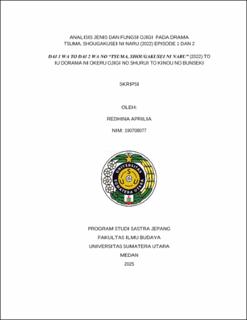Analisis jenis dan fungsi Ojigi pada Drama Tsuma, Shougakusei ni Naru (2022) Episode 1 dan 2
Analysis Of The Types And Functions Of Bowing In The Drama Tsuma, Shogakusei Ni Naru (2022) Episodes 1 And 2

Date
2025Author
Aprilia, Redhina
Advisor(s)
Alimansyar
Arfianty, Rani
Metadata
Show full item recordAbstract
This study aims to identify the types of ojigi (bowing) that appear in the Japanese
drama Tsuma, Shougakusei ni Naru (2022), episodes 1 and 2, and to understand the
cultural meanings and functions embedded in them. Ojigi is a form of nonverbal
communication that plays an important role in Japanese social interactions. By
analyzing selected scenes in which the characters perform ojigi, this research
explores the context of its use and the values conveyed through the gesture. This
study adopts a descriptive qualitative approach and applies semiotic theory as the
basis of analysis. This theory is used to uncover the symbolic and cultural meanings
implied in each ojigi movement presented in the drama. The analysis reveals two
types of ojigi, namely eshaku and keirei, each used in different social contexts and
relationships. These forms of ojigi serve four main functions: as an expression of
respect, gratitude, customer appreciation, and making a request. The findings
indicate that ojigi in the drama is not merely a physical act, but a reflection of deeply
rooted Japanese cultural values.
Collections
- Undergraduate Theses [593]
